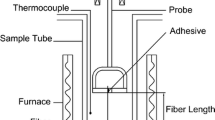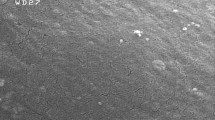Abstract
In this work, we compared thermal conductivities of polypropylene fibers and fibrils. The polypropylene fibers were melt spun, and oriented by solid-state drawing. Both wide-angle X-ray scattering and sonic velocity measurements were performed to determine the orientation of fibers. The thermal conductivities of fibers were measured via direct electrical heating method, and that of fibrils were measured via thermal bridge method. Our results show that the thermal conductivity of polypropylene fibers increases linearly with their sonic velocity. This suggests we can use the sonic velocity to characterize the thermal conductivity of semicrystalline polymers. Our results also indicate the average thermal conductivity of fibrils is close to that of fibers. This implies that the low thermal conductivity of polymer fibers is due to the low thermal conductivity of fibrils, instead of thermal resistance between fibrils.






Similar content being viewed by others
Data availability
The data are available from the corresponding author on reasonable request.
References
Huang C, Qian X, Yang R (2018) Thermal conductivity of polymers and polymer nanocomposites. Mater Sci Eng R 132:1–22
Xu X, Chen J, Zhou J, Li B (2018) Thermal conductivity of polymers and their nanocomposites. Adv Mater 30:1705544
Liu Y, Zhou Y, Xu Y (2022) State-of-the-art, opportunities, and challenges in bottom-up synthesis of polymers with high thermal conductivity. Polym Chem 13:4462–4483
Choy CL, Chen FC, Luk WH (1980) Thermal conductivity of oriented crystalline polymers. J Polym Sci Polym Phys Ed 18:1187–1207
Shen S, Henry A, Tong J, Zheng R, Chen G (2010) Polyethylene nanofibres with very high thermal conductivities. Nat Nanotechnol 5:251–255
Xu Y, Kraemer D, Song B, Jiang Z, Zhou J, Loomis J, Wang J, Li M, Ghasemi H, Huang X, Li X, Chen G (2019) Nanostructured polymer films with metal-like thermal conductivity. Nat Commun 10:1771
Zhu B, Liu J, Wang T, Han M, Valloppilly S, Xu S, Wang X (2017) Novel polyethylene fibers of very high thermal conductivity enabled by amorphous restructuring. ACS Omega 2:3931–3944
Singh V, Bougher TL, Weathers A, Cai Y, Bi K, Pettes MT, McMenamin SA, Lv W, Resler DP, Gattuso TR, Altman DH, Sandhage KH, Shi L, Henry A, Cola BA (2014) High thermal conductivity of chain-oriented amorphous polythiophene. Nat Nanotechnol 9:384–390
McDaniel PB, Deitzel JM, Gillespie JW (2015) Structural hierarchy and surface morphology of highly drawn ultra high molecular weight polyethylene fibers studied by atomic force microscopy and wide angle x-ray diffraction. Polymer 69:148–158
Petersmann S, Spoerk-Erdely P, Feuchter M, Wieme T, Arbeiter F, Spoerk M (2020) Process-induced morphological features in material extrusion-based additive manufacturing of polypropylene. Addit Manuf 35:101384
Zhao G, Li X, Tian Y, Wu G, Zhang Y, Jiang W, Yang J, Ni Z (2021) Poly(L-lactic acid) monofilaments for biodegradable braided self-expanding stent. J Mater Sci 56:12383–12393
Liu F, Liu X, Ai W, You S, Wang Y, Yang H, Bai Z, Liu H (2020) Optimization of the pre-tension and separation distance for measurement of the dynamic elastic modulus and macromolecular orientation of a polypropylene monofilament via the sonic velocity method. Rev Sci Instrum 91:123906
Yang J, Shen M, Yang Y, Evans WJ, Wei Z, Chen W, Zinn AA, Chen Y, Prasher R, Xu TT, Keblinski P, Li D (2014) Phonon transport through point contacts between graphitic nanomaterials. Phys Rev Lett 112:205901
Yang J, Kong L, Mu B, Zhang H, Li Y, Cao W (2019) Measurement of intrinsic thermal conductivity of carbon fiber using direct electrical heating method. Rev Sci Instrum 90:114902
Wang X, Yang J, Xiong Y, Huang B, Xu TT, Li D, Xu D (2018) Measuring nanowire thermal conductivity at high temperatures. Meas Sci Technol 29:025001
Wang X (2012) Experimental micro/nanoscale thermal transport. John Wiley & Sons Inc, New Jersey
Wingert MC, Chen ZCY, Kwon S, Xiang J, Chen R (2012) Ultra-sensitive thermal conductance measurement of one-dimensional nanostructures enhanced by differential bridge. Rev Sci Instrum 83:024901
Yang J, Tang H, Zhao Y, Zhang Y, Li J, Ni Z, Chen Y, Xu D (2015) Thermal conductivity of zinc blende and wurtzite CdSe nanostructures. Nanoscale 7:16071–16078
Kim P, Shi L, Majumdar A, McEuen PL (2001) Thermal transport measurements of individual multiwalled nanotubes. Phys Rev Lett 87:215502
Sun Y, Yang J (2020) Uncertainty analysis of the thermal bridge method. Int J Thermophys 41:146
Ma J, Zhang Q, Mayo A, Ni Z, Yi H, Chen Y, Mu R, Bellan LM, Li D (2015) Thermal conductivity of electrospun polyethylene nanofibers. Nanoscale 7:16899–16908
Yang J, Yang Y, Waltermire SW, Wu X, Zhang H, Gutu T, Jiang Y, Chen Y, Zinn AA, Prasher R, Xu TT, Li D (2012) Enhanced and switchable nanoscale thermal conduction due to van der Waals interfaces. Nat Nanotechnol 7:91–95
Assouline E, Wachtel E, Grigull S, Lustiger A, Wagner HD, Marom G (2001) Lamellar twisting in \(\alpha\) isotactic polypropylene transcrystallinity investigated by synchrotron microbeam X-ray diffraction. Polymer 42:6231–6237
Moseley WW (1960) The measurement of molecular orientation in fibers by acoustic methods. J Appl Polym Sci 3:266–276
Xi Q, Zhong J, He J, Xu X, Nakayama T, Wang Y, Liu J, Zhou J, Li B (2020) A ubiquitous thermal conductivity formula for liquids, polymer glass, and amorphous solids. Chin Phys Lett 37:104401
Mochizuki M, Nakayama K, Qian R, Jiang B-Z, Hirami M, Hayashi T, Masuda T, Nakajima A (1997) Studies on biodegradable poly(hexano-6-lactone) fibers 1. Structure and properties of drawn poly(hexano-6-lactone) fibers (Technical Report). Pure Appl Chem 69:2567–2575
Liu J, Yang R (2012) Length-dependent thermal conductivity of single extended polymer chains. Phys Rev B 86:104307
Funding
This work was supported by the Department of Science and Technology of Jiangsu Province (BK20220032), the National Natural Science Foundation of China (52206092, 52127811), Natural Science Foundation of Jiangsu Province (No. BK20210565), and the Fundamental Research Funds for the Central Universities (2242022K40022).
Author information
Authors and Affiliations
Contributions
Investigation: Hao Yin, Chenhan Liu, Bin Wang, Yong Li, Xue Hu, Junyao Yin; Formal analysis: Hao Yin, Chenhan Liu; Visualization: Jinbo Liu; Writing - Original Draft: Hao Yin; Writing - Review & Editing: Chenhan Liu, Gutian Zhao, Juekuan Yang; Conceptualization: Gutian Zhao, Juekuan Yang; Supervision: Juekuan Yang.
Corresponding authors
Ethics declarations
Competing interests
The authors declare no competing interests.
Additional information
Publisher's Note
Springer Nature remains neutral with regard to jurisdictional claims in published maps and institutional affiliations.
Rights and permissions
Springer Nature or its licensor (e.g. a society or other partner) holds exclusive rights to this article under a publishing agreement with the author(s) or other rightsholder(s); author self-archiving of the accepted manuscript version of this article is solely governed by the terms of such publishing agreement and applicable law.
About this article
Cite this article
Yin, H., Liu, C., Wang, B. et al. Comparison of thermal conductivities of polypropylene fibers and fibrils. Heat Mass Transfer 60, 677–684 (2024). https://doi.org/10.1007/s00231-024-03463-2
Received:
Accepted:
Published:
Issue Date:
DOI: https://doi.org/10.1007/s00231-024-03463-2




